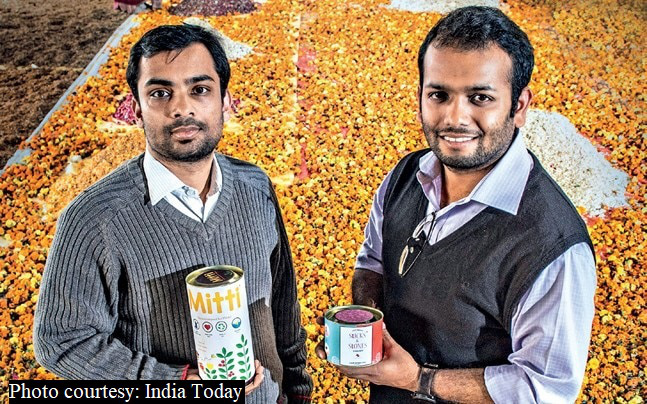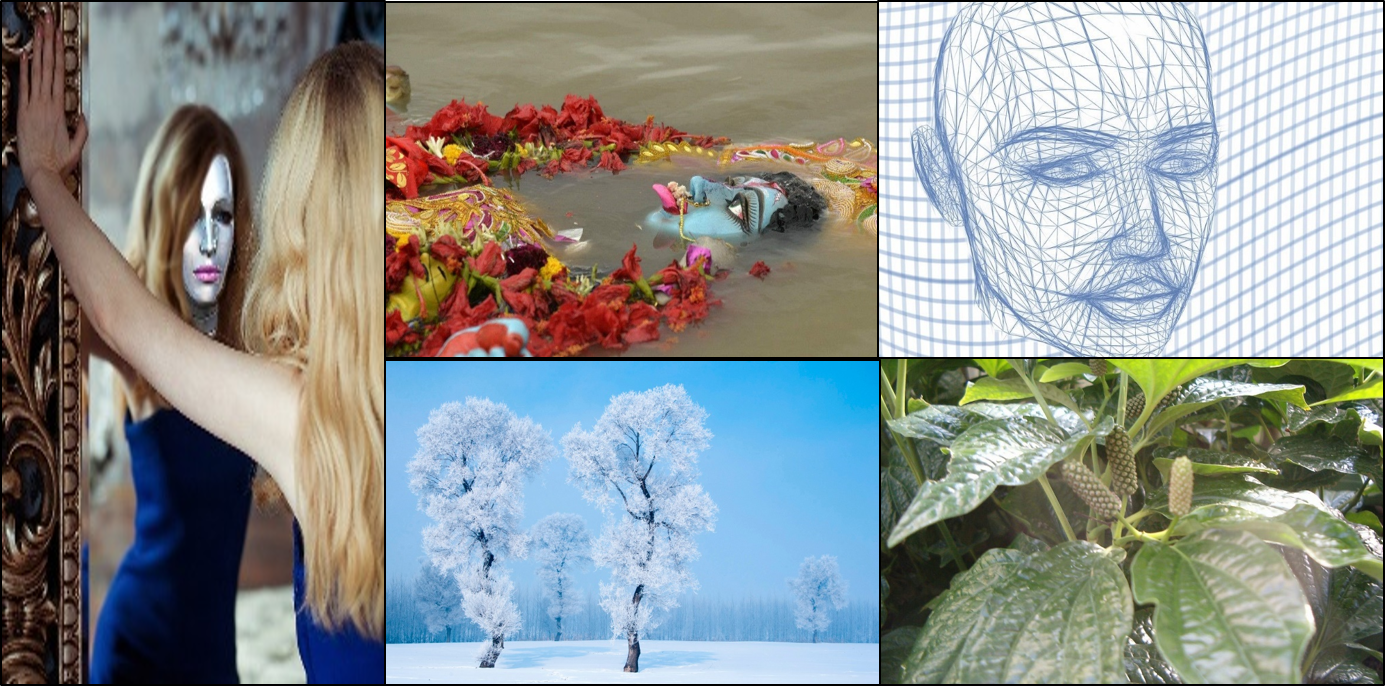Some like it Hot…….. and Spicy
It is difficult, if not impossible, to imagine our food without the hot and spicy flavor of green chilies. But, green chilies were the recent introduction to India in the fifteen century by the Portuguese traders. So, how was life before the arrival of green chilies? Did the absence of chilly mean no hot no spicy food? Was hot and spicy flavor squarely unknown to Indians? If not, what could have substituted green chillies in our cuisines?
food? Was hot and spicy flavor squarely unknown to Indians? If not, what could have substituted green chillies in our cuisines?
We did have our very own version of hot and spicy spices to flavor our food, be it fish, chicken, or meat or spicy veggies. The Piperaceae family is super-loaded with many species which are strong flavoring agents in their own right, black pepper or Piper nigrum, Piper longum or Indian long pepper or pipli, Piper retrofractum, etc. While two of the key players, black pepper and Indian long pepper remained conspicuous with their pomp and presence. But one member of the same family, Piper chaba, has been lost in the dust of history which was once a frequent ingredient of cuisines. One can find mentions of choi jhal (jhal = hot in Bengali) in the old historical texts.
Piper chaba is another member of the family Piperaceae which is a native of south and southeast Asia. It is distributed throughout India, Bangladesh, Malaysia, Indonesia, Singapore, and Sri Lanka. The plant is a creeper that trudges on the ground, can climb up, and grow around large trees like other piperaceous members. The leaves are oval, the flowers are monoecious, and blossom during the monsoon. The fruit is elongated in shape and looks very similar to the other varieties of long pepper. When ripe, the fruit first turns red and then turns dark brown or black upon drying.
P. chaba, Chui Jhal or Choi Jhal, is locally famous as a strong flavoring agent in the of southern Bangladesh, and the states of Tripura and West Bengal in India where the East Bengal diaspora prevailed. Generally, stem and roots are cut down, the skin is peeled, chopped it into small pieces, and cook them with sumptuous non-vegetarian items. The culinary tradition was also quite alive in the Indian states of West Bengal and Tripura where people use this spice similarly. In Bangladesh, the stems of the plant are used as a spice in meat and fish dishes. In that way, the use of Choi Jhal is quite unique, because the twigs, stems, or roots of P. chaba – not the fruit – are used as a spice.
So, when green chilies had arrived with the Portuguese, gradually embraced with open arms and made place in the local cuisines; it actually stepped in into the taste regime already created by local fiery hot spices of Piperaceae; waging a war against them, perhaps robbing of their dominance and shunting a few to oblivion.
Image source: CC BY-SA 3.0, https://commons.wikimedia.org/w/index.php?curid=658321; By Ferdous – Own work, CC BY-SA 4.0, https://commons.wikimedia.org/w/index.php?curid=74200769
Collector: Avik Ray
Artificial intelligence: the new normal
In the Covid-19 reality where even simple tasks are becoming increasingly digitized, we are made aware of the necessity of a ‘digital existence’. In the ‘dystopian future’ that we are living in, this comes as no surprise.
Let us however imagine an alternate scenario at the very beginning of the Covid-19 crisis; imagine being able to map, track and predict the spread of Covid-19. Could we have prevented this disastrous pandemic?
An advanced AI system will be able to do just that: process large amounts of complex, varied data sets to make accurate and fast predictions. All the nodes where the data points interact with each other would be scrutinized and an ‘intelligent’ model of action would be proposed depending upon our required outcome. This is not just true for spread of infectious diseases; complex data sets include locust attacks, global warming and weather patterns, analysis of biodiversity in systems and surprisingly enough: our thoughts.
to make accurate and fast predictions. All the nodes where the data points interact with each other would be scrutinized and an ‘intelligent’ model of action would be proposed depending upon our required outcome. This is not just true for spread of infectious diseases; complex data sets include locust attacks, global warming and weather patterns, analysis of biodiversity in systems and surprisingly enough: our thoughts.
Development and applications of AI systems are gaining momentum. It would be worth to note that neuroscience and ecology are the two fields that are perhaps benefitting the most from this.
In the human brain; billions of neurons interact by two major ways: binary firing and re-arrangement. As you are reading this article, your neurons are rapidly generating electric potentials and changing their network to result in what would be entirely unique to you. AI essentially allows us to ‘hack’ the neural networking. By ‘loading’ intelligent reasoning and cognises into artificial neural networks, neuroscientists will be able to tackle most of the medical cases involving poor functioning of our neural system. Whether it is neuro-motor diseases or mental health issues; AI developed neural networks might be our panacea. While this opens unexplored avenues of questionable practices such as mind control, controlling dreams and imagination among others, we cannot deny the eventual dependence of humans on AI rather than physical alternatives like medicine.
AI in ecology is also much-talked about. While neuroscientists are trying to understand the reason why we dream, why we are capable of imagination, etc… Ecologists are resorting to AI to look for sustainable conservation models that can provide solutions to Global Warming, Biodiversity waning, alternate farming practices and development models.
Take the emerging branch of ‘Climate Informatics’ ,for instance, where AI is employed in analysing complex weather patterns without biases in model generation that would drastically improve the accuracy in data science practises. Equipped with AI systems, your laptop could be your ‘supercomputer’; rendering research affordable and accessible to such an extent will accelerate development in the field exponentially. Apart from making accurate predictions based on complex, ‘real’ models, AI can also identify tipping points/extreme events to scales unfathomed previously. This comes in handy when we seek to combat loss due to natural disasters. Not only will we be able to predict the event but also be provided with ‘quick and smart models’ to handle the crisis with maximum efficiency. This idea penetrates even into conservation strategies where AI can help identify trends in ‘disappearance’ of various species taking into consideration all the factors relevant and suggest methods to conserve them. These predictions can be made way before the actual event to improve our responses.
 The use of AI in automated vehicles is also of paramount importance to the environment. By reviewing traffic patterns, enabling fuel optimisation, monitoring exhaust releases and coordinating with other intelligent systems, an ‘intelligent vehicle’ can bring down the pollution by a significant rate. The idea can be extended to ‘smart cities’ where automated systems coordinate with each other to monitor parameters such as electricity usage, water usage/waste ratios, traffic and vehicle exhaust levels, amount of green cover, etc and find trends in the lifestyles, culture, age, gender, etc of populations to optimise pollution mitigation measures by making it more customised to the population and thus more feasible.
The use of AI in automated vehicles is also of paramount importance to the environment. By reviewing traffic patterns, enabling fuel optimisation, monitoring exhaust releases and coordinating with other intelligent systems, an ‘intelligent vehicle’ can bring down the pollution by a significant rate. The idea can be extended to ‘smart cities’ where automated systems coordinate with each other to monitor parameters such as electricity usage, water usage/waste ratios, traffic and vehicle exhaust levels, amount of green cover, etc and find trends in the lifestyles, culture, age, gender, etc of populations to optimise pollution mitigation measures by making it more customised to the population and thus more feasible.
AI when incorporated into our satellites for ‘geo-mapping’ can track various pollution trends, deforestation, poaching, carbon footprints, industrial activity among other things to suggest an environmentally and economically feasible course of action for the future. Much like the smart cities, this can be tailored according to countries, development indices, biodiversity and topological features.
Of course, it would be worth to note that AI systems can learn from experience and from each other; it wouldn’t be a surprise if there are unexplored utility values of AI systems that come from the system’s own suggestions.
If these prospects seem ostentatious and flamboyant, we must remember that two months ago, no one had even imagined of the possibility of a pan-India digitized leaning….yet, look where we are now!
Some interesting questions to ponder upon when it comes to the applications of AI: Can we ‘induce’ morality in humans to conserve the environment? Can we analyse criminal behaviour and terminate its underlying cause? Can we substitute anti-depressants with neural re-wiring? Can we have successful and quick de-addiction sessions to eradicate alcoholism, smoking, etc? Can we solve the big conversation around consciousness? Will we understand the purpose of existence?
While some of these questions are being answered right now, there is lot of room to work on the others with the advent of AI as a ‘new normal’. With governments and global communities abandoning the ‘arms race’ and ‘space race’ for the new ‘Digital Race’ headed by the development of AI, we might get intertwined with the many moral, social and economic discussions around this new field of study. Nevertheless, AI is the new poster boy of the scientific community and shall soon revolutionize not just life on Earth but the very definition of life.
Source: https://www.nature.com/articles/d41586-019-02212-4
https://www.weforum.org/agenda/2018/01/8-ways-ai-can-help-save-the-planet/
Image: https://pixabay.com/images/search/robot/
Collector: Aishwarya H. Iyer
A solution to floral pollution
Flower means beautiful, soft, colorful, sacred, i.e.,, every possible word infuses something positive into it. Hence, the term floral pollution sounds a bit bizarre to us. But the facts and figures are not something to ignore, ~ 16% of river pollutants in India stem from floral wastes. A careful look at any urban or semi-urban waterbody reveals a good fraction of waste is from floral members. These wastes are mainly from temples (or other religious places) and from our households. The cultural-religious association of flower often precludes us to consider it as normal waste, therefore regular waste treatment plans turns futile. Although seems less harmful, flowers have their own role in pollution affecting aquatic life to a certain extent. Flowers are organic in nature, therefore, excess deposition in waterbody increases the organic load beyond the permissible limit. Similarly, pesticides and weedicides which are often used to grow flowers are also end up to the water.
it. Hence, the term floral pollution sounds a bit bizarre to us. But the facts and figures are not something to ignore, ~ 16% of river pollutants in India stem from floral wastes. A careful look at any urban or semi-urban waterbody reveals a good fraction of waste is from floral members. These wastes are mainly from temples (or other religious places) and from our households. The cultural-religious association of flower often precludes us to consider it as normal waste, therefore regular waste treatment plans turns futile. Although seems less harmful, flowers have their own role in pollution affecting aquatic life to a certain extent. Flowers are organic in nature, therefore, excess deposition in waterbody increases the organic load beyond the permissible limit. Similarly, pesticides and weedicides which are often used to grow flowers are also end up to the water.
Here is a story that tells about an exception. Kanpur, one of the prosperous cities in northern India on the bank of the river Ganges, had this floral waste problem. Along with the industrial and household effluents, flowers from temples and mosques also used to pollute the river on a regular basis. To deal with the problem, two young entrepreneurs, Ankit Agarwal and Karan Rastogi, adopted an innovative strategy which addressed multiple issues at a time. Their initiative ‘helpusgreen’ made an agreement with religious places to receive the temple waste, i.e., tons of flowers on a daily basis to their recycling unit. Those used up flowers are then recycled through ‘flower cycling’ technology to vermicompost and incense sticks for further use. Majority of the workers in their unit are women who earlier involved in manual scavenging activities, therefore have to withstand severe social stigma. Their inclusion in this initiative assured both social acceptance and economic upliftment This unique approach towards the environmental issue blended with social justice caught the attention of the United Nations Environment Program and is appreciated as one of the inspiring steps towards the sustainable development goals.
strategy which addressed multiple issues at a time. Their initiative ‘helpusgreen’ made an agreement with religious places to receive the temple waste, i.e., tons of flowers on a daily basis to their recycling unit. Those used up flowers are then recycled through ‘flower cycling’ technology to vermicompost and incense sticks for further use. Majority of the workers in their unit are women who earlier involved in manual scavenging activities, therefore have to withstand severe social stigma. Their inclusion in this initiative assured both social acceptance and economic upliftment This unique approach towards the environmental issue blended with social justice caught the attention of the United Nations Environment Program and is appreciated as one of the inspiring steps towards the sustainable development goals.
Image: moneycontrol.com, Economic Times, India Today
Collector: Rajasri Ray
Ice flower – Natures miracle
Come winter, life becomes standstill in many parts of the earth especially where human footprint is still not so dominant. However, there is no interruption in natural activities which often turns into a miracle. In Heilongjiang province of northeast China, Kurbin river area is famous for its ‘ice flower season’. The 220 km long river running from north to south mostly goes through temperate environment. During winter, the temperature goes down to -300C, creating a freezing condition in the northern region. As a result, trees become leafless skeleton of branches standing as guard at the river bank. However, due to the presence of a hydropower station at the upstream of the river, there is always a flow of water with temperature above 00C. This comparatively warmer water when comes in touch of the chilly environment, a foggy condition develops along the course of the river. At night, the water droplets present in the fog get crystalized and
not so dominant. However, there is no interruption in natural activities which often turns into a miracle. In Heilongjiang province of northeast China, Kurbin river area is famous for its ‘ice flower season’. The 220 km long river running from north to south mostly goes through temperate environment. During winter, the temperature goes down to -300C, creating a freezing condition in the northern region. As a result, trees become leafless skeleton of branches standing as guard at the river bank. However, due to the presence of a hydropower station at the upstream of the river, there is always a flow of water with temperature above 00C. This comparatively warmer water when comes in touch of the chilly environment, a foggy condition develops along the course of the river. At night, the water droplets present in the fog get crystalized and tiny ice particles are deposited over the bare branches of the trees, thus creating millions of icy crystals across the area fondly called as ‘rime’. These crystals cover the trees in such a way that it appears as winter bloom for the trees. The rime formation is a widely known phenomenon across the cold temperate region of China. Apart from Kurbin river, Wusong island near Songhua river, Tianmenshan Natioanl Forest Park in Hunan province are few famous spots for rime vision. The scenic landscape immersed in total tranquility attracts flocks of tourist from December to March every year to celebrate the Winter Flower Season and to enjoy the winter life on the Earth.
tiny ice particles are deposited over the bare branches of the trees, thus creating millions of icy crystals across the area fondly called as ‘rime’. These crystals cover the trees in such a way that it appears as winter bloom for the trees. The rime formation is a widely known phenomenon across the cold temperate region of China. Apart from Kurbin river, Wusong island near Songhua river, Tianmenshan Natioanl Forest Park in Hunan province are few famous spots for rime vision. The scenic landscape immersed in total tranquility attracts flocks of tourist from December to March every year to celebrate the Winter Flower Season and to enjoy the winter life on the Earth.
Image: Max Liang, www.xabusiness.com/china-stamps-1995/1995-2.htm
Collector: Rajasri Ray



